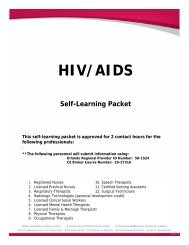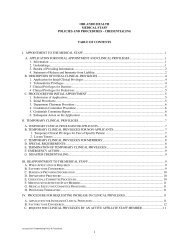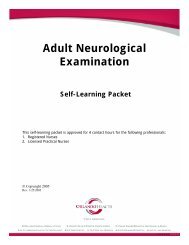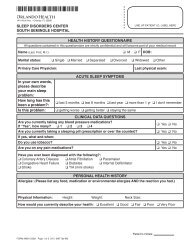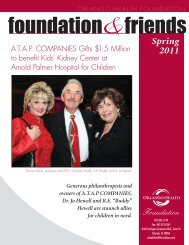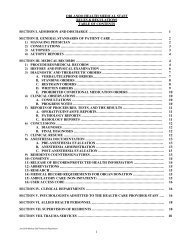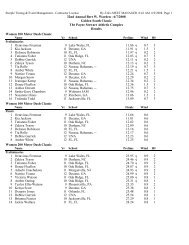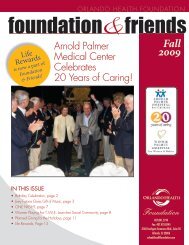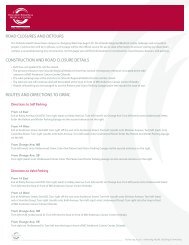Introduction to CV Pharmacology - Orlando Health
Introduction to CV Pharmacology - Orlando Health
Introduction to CV Pharmacology - Orlando Health
Create successful ePaper yourself
Turn your PDF publications into a flip-book with our unique Google optimized e-Paper software.
<strong>CV</strong> <strong>Pharmacology</strong><br />
Positive Inotropic Therapy<br />
Digoxin<br />
Our discussion of digitalis preparations will be limited <strong>to</strong> digoxin (Lanoxin, Digitek®) which is<br />
the most commonly prescribed form of digitalis. Digoxin is a positive inotropic agent as it<br />
increases the strength of myocardial contraction. Digoxin also decreases au<strong>to</strong>maticity and<br />
prolongs electrical conduction through the AV node.<br />
Indications<br />
Digoxin is used as maintenance therapy for symp<strong>to</strong>m control in patients with heart failure <strong>to</strong><br />
increase myocardial contractility, stroke volume, and cardiac output. It also is used <strong>to</strong> control the<br />
ventricular rate with atrial fibrillation or atrial flutter by slowing AV nodal conduction.<br />
Note: For initial ventricular rate control in atrial fibrillation, IV calcium channel blockers and<br />
beta-blockers are used before digoxin due <strong>to</strong> the length of time digoxin takes <strong>to</strong> produce a<br />
slowing of the ventricular rate.<br />
Precautions and Interactions<br />
Digoxin has a very narrow therapeutic range and <strong>to</strong>xicity can develop rapidly. Symp<strong>to</strong>ms of<br />
digoxin <strong>to</strong>xicity include nausea, vomiting, diarrhea, visual disturbances, and changes in mental<br />
status and level of consciousness. Toxicity also causes a wide variety of dysrhythmias, including<br />
heart blocks, junctional rhythms, and ventricular dysrhythmias. Toxicity is precipitated by<br />
hypokalemia, hyperkalemia, and hypomagnesemia. Many patients taking digoxin for heart<br />
failure also take diuretics that can deplete potassium and lead <strong>to</strong> <strong>to</strong>xicity. Be sure <strong>to</strong> provide<br />
patient education concerning the need <strong>to</strong> take any prescribed potassium supplements if the<br />
patient is on diuretic therapy.<br />
Digoxin is potentiated in such drugs as amiodarone, calcium channel blockers, and quinidine. In<br />
patients taking these drugs, digoxin should be used with caution and the dose might be reduced<br />
by 50%. Overdose of digoxin can be treated by the drug Digibind ® .<br />
Clinical Application<br />
Digoxin should be avoided with those patients with sick sinus syndrome or significant<br />
atrioventricular nodal heart blocks such as complete heart block and second degree AV<br />
block.<br />
Dobutamine<br />
Dobutamine (Dobutrex) is a synthetic catecholamine. It is a potent β 1 agonist <strong>to</strong> increase<br />
myocardial contractility and cardiac output. It is also a mild alpha agonist; however, the alpha<br />
effects are counteracted by the more potent β 2 properties, resulting in a mild vasodilation effect.<br />
This vasodilation will decrease preload and afterload with a beneficial effect on myocardial<br />
oxygen supply and demand. At doses of 2–20 mcg/kg/min, it has only a minimal effect on the<br />
heart rate. By increasing the cardiac output in the presence of mild vasodilation, it will increase<br />
coronary, renal and mesenteric perfusion.<br />
2010 <strong>Orlando</strong> <strong>Health</strong>, Education & Development 39



